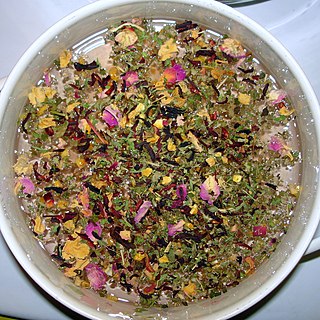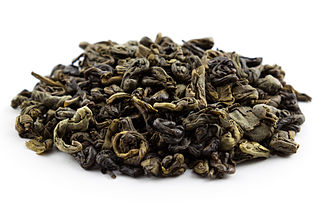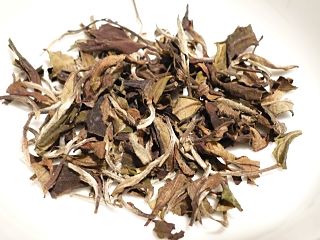Mint tea may refer to:
- Maghrebi mint tea, an infusion of leaves of tea plants with mint added as a flavoring
- Mint herbal tea, an infusion of leaves of mint plants
Mint tea may refer to:
Infusion refers to the process of extracting chemical compounds or flavors from plant material in a solvent by allowing the material to remain suspended in the solvent over time.

Mentha is a genus of plants in the family Lamiaceae. The exact distinction between species is unclear; it is estimated that 13 to 24 species exist. Hybridization occurs naturally where some species' ranges overlap. Many hybrids and cultivars are known.

Spearmint, also known as garden mint, common mint, lamb mint and mackerel mint, is a species of mint, Mentha spicata (, native to Europe and southern temperate Asia, extending from Ireland in the west to southern China in the east. It is naturalized in many other temperate parts of the world, including northern and southern Africa, North America, and South America. It is used as a flavouring in food and herbal teas. The aromatic oil, called oil of spearmint, is also used as a flavoring and sometimes as a scent.

Tea is an aromatic beverage prepared by pouring hot or boiling water over cured or fresh leaves of Camellia sinensis, an evergreen shrub native to East Asia which probably originated in the borderlands of southwestern China and northern Myanmar. Tea is also rarely made from the leaves of Camellia taliensis. After plain water, tea is the most widely consumed drink in the world. There are many different types of tea; some have a cooling, slightly bitter, and astringent flavour, while others have vastly different profiles that include sweet, nutty, floral, or grassy notes. Tea has a stimulating effect in humans primarily due to its caffeine content.

Herbal teas, also known as herbal infusions and less commonly called tisanes, are beverages made from the infusion or decoction of herbs, spices, or other plant material in hot water. Oftentimes herb tea, or the plain term tea, is used as a reference to all sorts of herbal teas. Many herbs are used in herbal medicine. Some herbal blends contain actual tea.

Mentha pulegium, commonly (European) pennyroyal, or pennyrile, also called mosquito plant and pudding grass, is a species of flowering plant in the mint family, Lamiaceae, native to Europe, North Africa, and the Middle East. Crushed pennyroyal leaves emit a very strong fragrance similar to spearmint. Pennyroyal is a traditional folk remedy, emmenagogue, abortifacient, and culinary herb, but is toxic to the liver and has caused some deaths. European pennyroyal is related to an American species, Hedeoma pulegioides. Though they differ in genera, they share similar chemical properties.

Yerba mate or yerba-maté is a plant species of the holly genus Ilex native to South America. It was named by the French botanist Augustin Saint-Hilaire. The leaves of the plant can be steeped in hot water to make a beverage known as mate. Brewed cold, it is used to make tereré. Both the plant and the beverage contain caffeine.

Lapsang souchong or Zhengshan xiaozhong is a black tea consisting of Camellia sinensis leaves that may be smoke-dried over a pinewood fire. This smoking is accomplished either as a cold smoke of the raw leaves as they are processed or as a hot smoke of previously processed leaves. The intensity of the smoke aroma can be varied by locating the leaves closer or farther from the source of heat and smoke or by adjusting the duration of the process. The flavour and aroma of smoked lapsang souchong is described as containing empyreumatic notes, including wood smoke, pine resin, smoked paprika, and dried longan; it may be mixed with milk but is not bitter and usually not sweetened with sugar. The tea originates from the Wuyi Mountains region of Fujian and is considered a Wuyi tea. It is also produced in Taiwan. It has been labelled as smoked tea, smoky souchong, tarry lapsang souchong and lapsang souchong crocodile. While the tea leaf grading system adopted the term souchong to refer to a particular leaf position, lapsang souchong may be made with any leaf of the Camellia sinensis plant, though it is not unusual for the lower leaves, which are larger and less flavourful, to be used as the smoking compensates for the lower flavour profile and the higher leaves are more valuable for use in unflavoured or unblended teas. In addition to its consumption as a tea, lapsang souchong is also used in stock for soups, stews and sauces or otherwise as a spice or seasoning. Beginning in the early 21st century, an unsmoked variety of lapsang souchong was developed in the village of Tong Mu Guan in the Wuyi mountains. The unsmoked variety has become increasingly popular, particularly in the Chinese domestic market.
Although health benefits have been assumed throughout the history of using Camellia sinensis as a common beverage, there is no high-quality evidence that consuming tea confers significant benefits other than possibly increasing alertness, an effect caused by caffeine in the tea leaves. In clinical research conducted over the early 21st century, tea has been studied extensively for its potential to lower the risk of human diseases, but there is no good scientific evidence to indicate that consuming tea affects any disease or improves health.

Maghrebi mint tea, also known as Moroccan mint tea and Algerian mint tea, is a North African green tea prepared with spearmint leaves and sugar.

Hōjicha is a Japanese green tea. It is distinctive from other Japanese green teas because it is roasted in a porcelain pot over charcoal. It is roasted at 150 °C (302 °F) to prevent oxidation and produce a light golden colour, as opposed to other Japanese teas which are steamed. In general, the base of a hōjicha consists of leaves from the second harvest or after.

Gunpowder tea is a form of tea in which each leaf has been rolled into a small round pellet. Its English name comes from its resemblance to grains of gunpowder. This rolling method of shaping tea is most often applied either to dried green tea or oolong tea.

Bai Mudan (Chinese: 白牡丹; pinyin: bái mǔdān; Wade–Giles: pai2 mu3-tan1; lit. 'white peony') is a type of white tea made from plucks each with one leaf shoot and two immediate young leaves (one bud two leaf ratio) of the Camellia sinensis plant. Bai Mudan is sometimes preferred by white tea drinkers for its fuller flavor and greater potency than the other major type of white tea, Bai Hao Yinzhen. The latter is made purely with leaf shoots, and so it is comparatively softer and more subtle. The typical taste of Bai Mudan is a result of both the processing and the tea plant cultivars employed in the production.

Infusion is the process of extracting chemical compounds or flavors from plant material in a solvent such as water, oil or alcohol, by allowing the material to remain suspended in the solvent over time. An infusion is also the name for the resultant liquid. The process of infusion is distinct from both decoction—a method of extraction involving boiling the plant material—and percolation, in which water is passed through the material.

Tagetes lucida is a perennial plant native to Mexico and Central America. It is used as a medicinal plant and as a culinary herb. The leaves have a tarragon-like scent, with hints of anise, and it has entered the nursery trade in North America as a tarragon substitute. Common names include sweetscented marigold, Mexican marigold, Mexican mint marigold, Mexican tarragon, sweet mace, Texas tarragon, pericón, yerbaniz, and hierbanís.

Prunella vulgaris, the common self-heal, heal-all, woundwort, heart-of-the-earth, carpenter's herb, brownwort or blue curls, is a herbaceous plant in the mint family Lamiaceae.

Matte Leão is a Brazilian infusion and tea brand, now owned by The Coca-Cola Company. The spelling Matte is archaic, but preserved in the trademark; the currently correct Portuguese spelling for the herb and the derived beverage is mate. Matte Leão offers a range of over 100 types of infusions.

Sencha is a type of Japanese ryokucha which is prepared by infusing the processed whole tea leaves in hot water. This is as opposed to matcha, powdered Japanese green tea, where the green tea powder is mixed with hot water and therefore the leaf itself is included in the beverage. Sencha is the most popular tea in Japan.

Brazilian tea culture has its origins in the infused beverages, or chás, made by the indigenous cultures of the Amazon region and the Rio da Prata basin. It has evolved since the Portuguese colonial period to include imported varieties and tea-drinking customs. There is a popular belief in Brazil that Brazilians, especially the urban ones, have a greater taste for using sugar in teas than in other cultures, being unused to unsweetened drinks.

Mexican tea culture is known for its traditional herbal teas which are reputed to have medicinal properties. In recent decades, imported tea beverages have also become popular in Mexico. Mexican tea recipes have grown in popularity beyond Mexico as well.